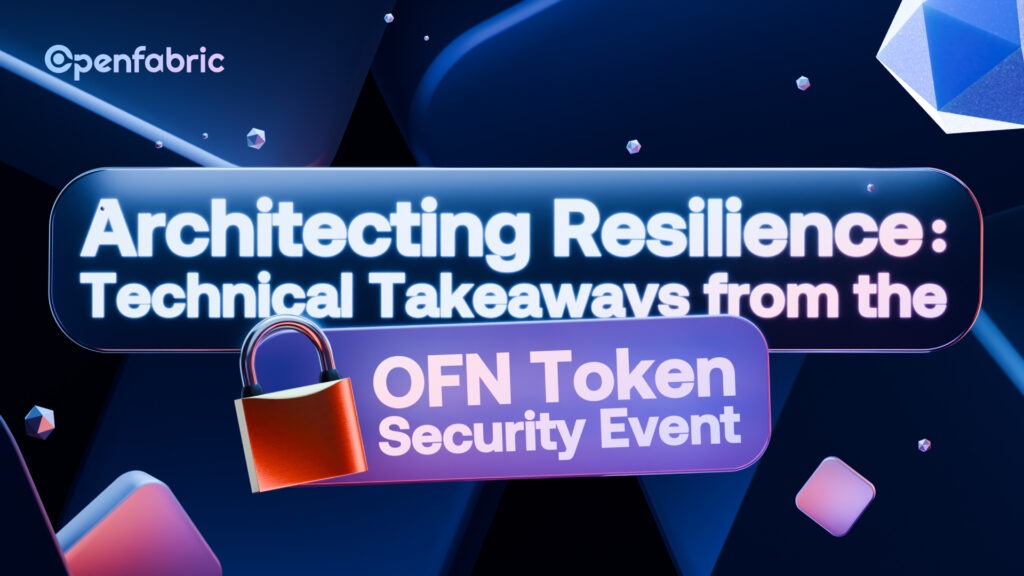
July 24, 2025 7 minutes read
Architecting Resilience: Technical Takeaways from the OFN Token Security Event

During the past week, an adversary obtained control of our operational vesting wallets (single-key EOAs), initiated unauthorized transfers of $OFN, and partially off-loaded the assets across both DEX and CEX venues. This event triggered a rapid price dislocation. The incident was caused by an issue in the key-management system: insufficient signer redundancy, absence of transaction policy enforcement (rate limits/cooldowns), and limited real-time anomaly detection. These are the issues that persist, in varying degrees, across much of the crypto industry.
The breach was initiated from outside, taking advantage of an architectural gap rooted in the technology constraints present at deployment. Nearly two years ago, when the vesting system went live, multisig/TSS solutions couldn’t yet be integrated with the used vesting smart-contract frameworks, so the wallets overseeing the vesting contract had to remain single-signature.
Because of that, we deferred multisig enforcement on the vesting path, assuming a later migration once the ecosystem stabilized. That migration lagged, and the leftover single-key design became the exploitable weak point.
In practical terms, one compromised key equaled unrestricted access to release and transfer functions. This included no quorum check, no timelock, no on-chain rate limits to throttle abnormal flows. The attacker simply stepped through that vulnerability. The lesson learned is clear: “temporary” security shortcuts have a way of becoming permanent liabilities if they aren’t tracked, budgeted, and retired on a schedule.
Going forward, those vesting controls are being re-platformed onto a k-of-n multisig/threshold signing setup, wrapped in a timelocked policy layer and backed by real-time anomaly detection. This closes the single-key gap and ensures any future change or token movement requires multiple independent approvals and a visible delay window.
The most significant impact has been to Openfabric’s reputation, and the team is working relentlessly to earn back the community’s trust.
Industry signal, not an outlier: 2025 has already blown past prior loss records. Chainalysis’ mid-year update pegs theft at $2.17 B in H1 2025, already exceeding all of 2024, with projections topping $4.3 B by year-end if trends persist.
Anchor event – Bybit: On Feb, 2025, hackers (attributed to North Korea by the FBI) drained roughly $1.5 B in ETH from Bybit—the largest single crypto heist to date.
Follow-on breaches (sampling 2025 H1):
- CoinDCX (India): ≈ $44 M stolen, adding to the H1 surge.
- BigONE Exchange: Hot-wallet compromise for about $27 M across BTC, ETH, USDT and more.
- Dozens of smaller incidents: CertiK counts 344 security events in H1, with total losses ~$2.47 B (adjusted ≈ $2.2 B after returns).
Takeaway: This isn’t alarmism, it’s a pattern. Sophisticated actors are targeting operational keys, vesting/bridge logic, and poorly governed upgrade paths. Multisig/TSS on release wallets, timelocks, rate limits, and real-time anomaly detection must be baseline, not “phase two” features.
These figures aren’t for panic, they’re a mandate. The industry needs tighter security controls end to end, and investors must stay vigilant for anomalous activity. Greater on-chain transparency and decentralization also help: funds are traceable, and bad actors can be identified and held accountable.
Best Practices on Security Multisig Architecture
Signer topology and threshold math
Use an m-of-n quorum on a Safe (Gnosis Safe) to control staking wallets. Let the signer set be {s1…sn}; any state-changing transaction must collect at least m signatures. If each signer has an independent compromise probability p, the breach probability is P_breach = Σ (i = m..n) [C(n,i) * p^i * (1–p)^(n–i)]. Choose m and n so P_breach fits your annual risk budget while keeping the system live if up to (n–m) signers are offline. Spread signers across internal teams (Ops, Security Engineering, Finance) and include external parties to reduce correlation.
Custody heterogeneity and hardware controls
Each signer uses a dedicated Ledger or HSM-grade device with a unique seed, passphrase, and verified firmware. Separate devices physically (different sites/jurisdictions) and logically (different networks/ISPs). Add at least one MPC/TSS participant (e.g., GG18/GG20 or FROST) to further decorrelate key exposure. Store only encrypted, split-backup shards—never full seeds—and enforce strict, documented recovery procedures.
Safe modules and on-chain policy enforcement
Enhance the Safe with policy modules: a timelock/delay module (e.g., Zodiac Delay) for high-impact operations like threshold changes or staking parameter edits; a Guard contract that enforces function allow lists and quantitative rate caps (for example, per-epoch withdrawals capped at mean plus three standard deviations over a rolling window); a circuit-breaker module that auto-reverts transactions flagged by an anomaly oracle. Block delegatecall and arbitrary module installs by default; changes to module configs require the same m-of-n quorum.
Operational workflow and key ceremonies
All privileged actions follow a two-step process: propose (hash the call data on-chain and open an internal ticket) and execute after a minimum delay (typically 24–48 hours). Run quarterly key-rotation ceremonies: rotate at least one signer, attest device integrity, and provably retire old keys. Any signer change or threshold adjustment is itself a timelocked Safe transaction (swapOwner, changeThreshold).
Telemetry, detection, and automated pauses
Stream Safe events and staking contract logs into an off-chain monitor. Build feature vectors from function selector, amount, gas, involved signers, and inter-transaction intervals. Use statistical methods (Poisson/z-score) or ML models (Isolation Forest) to detect anomalies. When thresholds are breached, automatically trigger pause() on staking contracts via a pre-authorized Guardian Safe with a smaller emergency quorum that can only freeze, not move, funds.
Verification, audits, and immutable specs
Define invariants such as “only the Safe may call stake() or unstake()” and “no single signer can escalate privileges.” Encode these with Scribble/Echidna; run Slither/MythX for static and dynamic analysis. Commission external audits (for example, CertiK) for the Safe module stack, guards, and monitoring logic. Publish audit hashes and Safe configuration CIDs so the community can verify that no silent changes occurred.
Continuous risk governance
Track KPIs: mean time to detect (MTTD) under 60 seconds, mean time to respond (MTTR) under 10 minutes, signer liveness over 99 percent, and yearly red-team exercises. Revisit m and n annually; if signer reliability changes or threats evolve, adjust (e.g., move to 6-of-9 or hybrid TSS plus multisig). Maintain a register of temporary exceptions with deadlines so stopgaps don’t become permanent. Monitor emerging standards (SafeSnap, FROST for ECDSA, new Guard patterns) and iterate—security is a dynamic process, not a one-off fix.
Moving forward: Next steps following OFN token security event
Going forward, moving control of treasury and vesting flows into a Gnosis Safe using an m-of-n quorum (currently 5-of-7). All contract ownership and privileged roles were shifted from EOAs to this Safe, which is wrapped by a timelock/guard layer that enforces per-function rate limits and cooldowns. Each signer holds a dedicated hardware key (Ledger/HSM) with its own seed and verified firmware.
Breach probability drops from p (single key) to:
P_breach = Σ_{i=5..7} C(7,i) · p^i · (1–p)^(7–i)
At p = 0.05, that’s about 6.0×10⁻⁶ (~1 in 166,000), roughly 8,000× safer than a single key, while still allowing two signers to be offline.
Multiple multisigs can be chained for critical actions—e.g., require both a 5-of-7 Treasury Safe and a 3-of-5 Guardian Safe. If they’re independent, the combined breach chance is the product: P_total = P_treasury · P_guardian. Using the numbers above, that’s ~6.9×10⁻⁹ (~1 in 145 million). (If either Safe can act alone, use P_total = 1 – (1 – P_treasury)(1 – P_guardian).)
Thresholds and signer sets remain upgradeable, but only through the same quorum-plus-timelock path, so we can move to 6-of-9 or add MPC/TSS signers later without reintroducing single-key risk. Every upgrade, parameter change, or emergency move now needs multiple independent approvals and a delay window, eliminating single points of failure.
Conclusion
The OFN token security incident understandably dented confidence, and operational constraints at the time delayed the rollout of a more resilient multisig configuration. That delay has now been resolved, and every remaining control surface is being tightened—no interim measure will be left standing.
In today’s blockchain ecosystem we are effectively at war with malicious actors—hackers and opportunists who actively try to break what we build. Our only real weapons are the tools of science: rigorous engineering, cryptography, formal methods, and data-driven monitoring. Once this incident is fully contained, we’ll double down on designing, augmenting, and improving state-of-the-art security systems with AI assistance—because no one should have to suffer from exploit-driven losses.
2025’s surge in breaches shows attackers aren’t slowing down. Neither can we. Security is shared: we’ll harden infrastructure; we ask the community to stay vigilant, question anomalies, and protect personal keys.
Openfabric is committed to transparency, rapid response, and continuous improvement. We’ll rebuild confidence through actions, not promises—and come back stronger.

